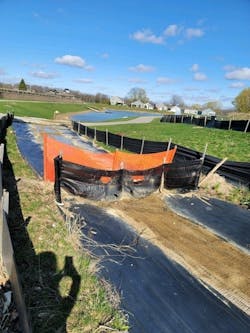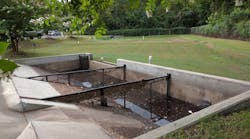Cherie Koester is CEO of Earthworks Environmental. Koester can be reached at [email protected].
undefinedHalf of the world's population lives in urban areas, and it is expected that by 2050 that figure will rise to above two-thirds. Cities have paved over natural green spaces to make way for streets, homes and commercial developments. Over the past two decades, urban storm water management has evolved from fast removal of runoff to comprehensive and cost-effective management approaches. Modern storm water management approaches, which are based on the implementation of storm water quantity and quality controls in various parts of urban catchments and their drainage systems, are now reviewed both in person and are managed by the latest technological advancements. These new technologies present a more effective and innovative approach to storm water management, leading to savings on drainage infrastructures and further robust protection of the environment.
Increased urbanization has a direct impact on the local hydrologic cycle. The results are storm water volumes and pollution are getting more critical. Suppose the effects of urbanization are not appropriately managed. In that case, channel geomorphology and aquatic ecology will degrade, stream base flow will decrease, water quality will diminish, and flooding frequency will increase. Managing storm water runoff is a particular challenge in urban areas. The design of conventional storm water management systems is currently undergoing scrutiny and revision. The result of that revision is modern sustainable urban drainage methods and measures available for storm water management.
New technologies have been vital as urbanization has negatively affected changes in natural precipitation and storm water runoff, which has produced more frequent flooding and landslides. The increased quantity of storm water that drainage channels have to collect is also evident through increased runoff storm water pollution. With this in mind, drainage systems and storm water management protocols should be adapted to constant change to mitigate new hydrological conditions' adverse effects.
Technology & the Permitting Process
Storm water permitting on residential and commercial properties is regulated by the federal and local governments. Permits are required for any soil disruption more than one acre. States can demand more stringent requirements, but they have to at least meet the federal requirements. The rule that everybody has to follow is always federal. Federal is the guideline. Beyond that, each municipality or county has to at least meet both entities' requirements. Municipalities and counties will often have additional permit requirements, record keeping, etc., depending on the project location and specific geographic requirements.
Permits generally last one to five years, depending on the state. Typically, one gets a permit and it is good for five years but has a yearly renewal fee. For multiple project sights this can get tricky if not properly managed.
For example, if there is a new housing development, that is one permit. Some states will allow users to increase their permit to allow multiple acres and others will not. Technically, one can be managing multiple sites across multiple states that might have eight to 10 different permits per project site because the work has been phased.
Technology has undoubtedly increased the speed at which we can apply for permits, get them submitted to the state and get them paid so that the permit is live quicker. Of course, that depends on each state as each has its separate system of how they accept permits and applications.
The ones that have moved over to an electronic system are beautiful because the application can be put online. We can pay for it online, bill the client later and then everything runs smoothly. Some states are approved when one hits submit and pay and can start being operated immediately. Others have a waiting period, and you have to wait for the approval letter before operating. Technology helps get a project started faster and helps track multiple permits to stay in compliance.
Record-Keeping at the Swipe of a Tablet
On the other side, the record-keeping piece is equally benefited with today’s technology. Earthworks Environmental’s proprietary ERX system uploads and maintains all records and permits per project and is accessible to anybody associated with a particular project. Everything is uploaded into ERX. All updates are available in real-time, which is essential when dealing with storm water management, especially the maps feature. For example, let us say there is a new silt fence on a project site. Site inspectors mark showing that there is a silt fence in this area. When an area manager or a land manager wants a real-time view of a project site, they simply pull up the location on ERX. It is crucial that the site management team maintain consistent record keeping and updated to involve parties. This level of technology on a job site keeps things organized and tracked, especially the permits.
The other interesting technology that has become useful with storm water management is electronic rain gauges. When Earthworks was first started, everybody had a little rain gauge at their project site, and they would have to go out every morning to check the site. Since there is now an integrated technology with the ERX system, the team members get an email daily telling them which sites have had rain events. The program will inform the team where rain inspections are needed, and then on top of that, it takes all of that rain data, and it puts it into a rain log, which is one of the requirements of the state and federal permits to keep a rain log of every single day of rain on every single site.
Meandering Storm Water Through Lincoln Valley
The residential project at Lincoln Valley in Chicago is exciting from a technological standpoint. It is unique in its challenges as it was a former golf course. This left the soil pulverized into super fine clay particles that can just quickly get through things. Additionally, the site sits on a slope going to four different outfalls right by Route 25, straight to the Fox River. The problem is digging out the basins while at the same time finding a place where the water can be cleaned before it goes into the outfall. That is essentially the unique challenge of Lincoln Valley is you have fine clay particles on a grade next to a major waterway.
To further complicate the issue, the regulator lived down the street, so there was more than usual oversight on that project. Having the permits and site inspections available through the ERX system allowed the team to stay up to date with this particular regulator and reduce the frequency they visited the site. Through ERX, the team sent pictures and reports at a higher frequency to ensure the site was staying within compliance.
To address the storm water situation, the client installed a “slip-n-slide” to move storm water around the project site safely. The reason for the extra effort was due to a stream that came onto the site. It meandered through the site and dumped off into the Fox River, which already has sensitive water. They diverted the water back and forth through flocculants and straw models to clean the sediment out of that water before converging into Fox River. It worked well and maintained compliance and regulatory standards.
Programs like ERX allow teams to constantly update the project site reports and keep all interested parties informed, especially given the meandering storm water system's sensitivity. Having many people distributed on the reports makes it easier to keep a large number of individuals informed.






